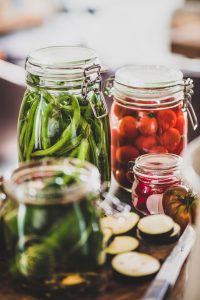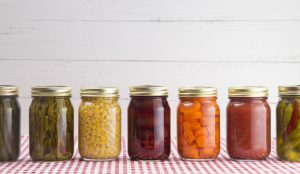One of the best parts about homesteading is the garden-fresh produce that you’ll grow. Have you ever heard someone say “nothing tastes better than a home-grown tomato”? That couldn’t be more true. Produce that you’ve grown yourself always tastes better than what you can buy in the grocery store or even at a local farmer’s market.
But what do you do when your garden grows a little too much? We have a saying in our family about the fact that your garden can never produce too much. When you find your refrigerator overflowing with fresh vegetables from your garden, it’s time to start thinking about how you’re using it. Instead of making yourself a fresh salad in the evening or trying to stir-fry all of your summer squash, consider canning some of your produce. (We won’t tell you that August 8 is National Sneak a Zucchini on your Neighbor’s Porch Day.)

Canning Basics: Two Methods
Many people never venture into the world of beautifully colored and filled mason jars because they get intimidated by canning. Don’t let canning intimidate you! It’s simple. In fact, so simple that we can break it down into two categories: pressure canning and water bath canning.
Water bath canning is the easiest method and the perfect place for beginners to start. Water bath canning doesn’t require any complicated kitchen equipment- just a large pot big enough to fill with water and cover your mason jars with a couple of inches of water. A large stock pot will usually do for this.
When you water bath can, you’ll fill your mason jars with acidic foods, pack the jars and load them into the water bath canner. The hot water in the water bath will help the lids to seal securely, keeping your foods fresh in the jars.
The difference between water bath canning and pressure canning is with the food that you’re trying to can. Foods that you seal with a water bath should be acidic foods. This could be tomatoes, jams and jellies made with pectin or Sure-Jell, pickles or other foods that are acidic. If you add lemon juice or vinegar to it, odds are that it’s an acidic food and can be preserved and sealed up just using a water bath.
Foods that aren’t acidic will need to be sealed up using a pressure canner. Green beans, meat, soups, relishes without vinegar and other non-acidic foods need to be sealed in a pressure canner. A simple pressure cooker will do for this. Non-acidic foods need a pressure cooker to seal them up and kill any potential bacteria that may be lurking in the food before it becomes shelf-stable. Acidic foods will kill unwanted bacteria just with the acidity that they have. That’s why they don’t require a pressure canner but non-acidic foods do.
Pressure canning is slightly more involved, so you’ll want to master water bath canning before moving to pressure canning.

Starting with Canning
There are a few tools and pieces of equipment that you’ll need to start water-bath canning. You’ll need a deep stock pot, mason jars with unused lids and rings. You may also want to splurge on canning funnels and a pair of canning tongs to make the process easier.
Canning tomatoes or making jelly is the easiest way to start canning. Grab yourself a pack of Sure-Jell to make your first batch of jelly or jam. The insert inside the box has step by step instructions to guide you through the process.
Pack your hot and clean jars with hot produce. Wipe the rim of the lid with a paper towel dampened with white vinegar. Pop a warm, unused lid on and then place a ring on the jar until it is fingertip-tight.
Once the jar has had a chance to cool, the lid should have a visible depression in it. That’s how you know that it’s sealed properly.
Getting started with canning is easy. Grab a basket of tomatoes or your favorite fruit and get started today!